|
Shrines
that Inspire
Mohan Kishen Tiku, Jammu
Kashmir
is rich not only in scenic beauty, but also in historical remains which bear
testimony to the architectural greatness and religious fervour of its people. No
wonder, therefore, that besides being known as the Abode of Snow,
Kashmir is also described as the Temple of God.
Places of worship, and centres of pilgrimage of
historical interest abound in all parts of Kashmir.
The following are some of the more important of
these.
Khir-Bhawani Temple :
The shrine is situated to the north of the
Sirinagar city at a distance of about 24 K.M. The shrine is dedicated to Goddess
Ragnya Devi, popularly known as Khir-Bhawani. (Fig 1) There is a spring where
the water occassionally changes colours and this curious phenomenon attracts a
number of yatris every year.
As regards the age and the sanctity of this
famous shrine of Kashmir, the award of the `Tirth-Sangrahi' and the tradition is
unanimously the same. This shrine of Kashmir is as old as the human being in
Kashmir. It is said that it was during the period of Ramayana, that Goddess was
moved from Lanka (Ceylon) to Satisar (Kashmir).
In Ceylon, Rawan began to perform penance for
one thousands years. Goddess was pleased to see this, and gave darshan to Rawan.
She as per request of Rawan selected North-Western corner of Lanka as Her abode,
and sitting at the back of Anantserpent, the goddess appeared in the human form,
and gave darshan to Rawan in nine different forms from time to time.
Rawan, being now the devotee, was given Kingdom of Lanka. At the time of
invasion of Lanka by Shri Ram, Hanuman was ordered to take away the Goddess on
the back of Anant serpant to Satisar (Kashmir). The night when Maharaginya came
to Kashmir is named as Ragni-Ratri and Goddess is worshipped as Maharagni.
For centuries people knew nothing of this sacred
spring which was subsequently discovered by Pandit Govind Joo Gadoo of
Bohri-Kadal, Srinagar. Goddess appeared to him in a dream and was ordered to
visit the place. He arranged a boat and went to Tulla Mulla abode of Goddess
with number of earthern vessels filled with milk, and when he reached the spring
he poured milk into it. There is another version of process which is said to
have brought the Shrine to notice One Kashmiri-Pandit saw a vision in which he
was asked by an Angel that the spring of Khir-Bhawani lay among the swamps of
Tulla Mulla village. The Pandit was surprised on this account. It was difficult
task for him to reach the main spot of the holy spring. A voice came to him and
asked Pandit to engage a boat near Shadipore and from this place a Serpant would
guide him. As soon as the spot would be reached, the Serpant would jump in a
spring which is the abode of Goddess. He did as was told and reached the main
spot. Thus was the divine spring of Kashmir discovered. Krishna Pandit along
with other persons from the city inaugrated worship of the Goddess - first of
its kind. After the puja was finished, it is said that a piece of birch was seen
floating over the water of the spring. The piece was collected, and to his great
surprise, he found a `Shaloka' written on it. Now gradually the place became
known all over the Kashmir and outside too.
The main spring is dedicated to Goddess Khir
Bhawani. It is irregular in shape being Septagonal with apex called Pad
(feet) to the east. The Southern and Northern sides are a bit longer than the
western side, commonly called Sher (Head). In the centre is an islet on
which a temple is believed to have existed. Sikander Butshikan destroyed this
temple also. Maharaja Partap Singh got constructed the present marble temple
under the supervision of Pt. Ved Lal Dhar, (father of Bal Kak Dhar - Rayis of
Kashmir) in the year 1869.
On Durga Ashtmi, the 8th day of the bright
fortnight of Chet and on Jeth-Ashtami, large fairs are held at this Shrine,
which is attended by devotees. People going there for worship do not take fish,
meat or eggs, and should take a bath before they enter the main place.
Muslims of this place offer flowers through
their Pandit friends, while addressing the Goddess as `Maej Bhagvati' (Mother
Goddess). This Shrine is reached by road and by boat too. The Shrine is under
the control of Jammu and Kashmir (J&K) Dharmaith - Trust.
Raginya - Pradurbhava,
in its last chapter, mentions about this shrine in detail. Last year the fair
took place on 30th May. The Government had made all possible arrangements for
the convenience of the pilgrims. From Jammu number of people (both Kashmiri and
local) visited the shrine; people from Delhi and other places also visited this
pilgrim centre in large numbers.
Historical References :
Kalhana's Rajatarangini is the oldest and
recognised record of Kashmiri History. We find many references about village
Tulla Mulla, and Khir-Bhawani Temple. Ragyana Pradurbhava in its last
chapter mentions about this shrine in the section Bringish-Samhita.
`Ramayana' describes lucidly all about this island. We also find many
interesting references in the famous historical treatise written by Abu-Fazal.
This famous historian of Akbar, has also mentioned in his book "Ain-i-Akbari"
about this Shrine of Kashmir. Charles Ellisian Bates has also written in his
`Gazette' about this famous spring - shrine.
In the summer of 1898 Swami Vivekananda visited
this shrine. Swamiji became devotee of `Mother', and said, "No more `Hari
Om;'" It is all `Mother now.' Maharaja Partap Singh built a marble temple
on the old site in the centre of the spring.
The Khirbhawani Reconstruction committee has
constructed some shelters for performing Hawan, and also laid two parks on each
side of the entrance.
Hari Parbat Shrine :
The sacred shrine on the hillock of Hari Parbat
(Fig. 2) is situated at a distance of 4 Km from Srinagar city. The hill can be
seen from about 32 Km from the western side of the city. There is a legend
associated with this hillock. Two demons lived near by. Both of them hid
themselves in water near the place where the Hari Parbat stands today and
harassed the rishis. The rishis prayed to Goddess Parvati to free
them from the demons. The Goddess assumed the form of `myna' (har) and
dropped a celestial pebble on the two demons. This pebble grew into a hillock
and the two demons were pinned to the spot for ever. Outside the Sangin-Darwaza
of the fort, a depression in the ground is pointed out, as the spot where from
the panting breath of the demons forced its way out. The Goddess in grateful
memory of her deliverance took up her abode here, and is now worshipped here as
Sharika. The hill is hence called Hari Parbat. There is a fort on the hillock
which was built by Azim Khan, the Pathan Governor. In 1590 A.D., Akbar the
great, built the outer wall at a cost of two crores. In the interior of the fort
there is a temple of Goddess Sharika. Thousands of Hindus daily go round the
hillock and offer prayers. On Har Nawmi, the 9th day of the bright
fortnight of Har (June-July) a great festival is held here. There are two
gates, Sangin Darwaza and Kathi Darwaza in the rampart of this fort.
Temple At Khrew :
The village of Khrew is about 18 K.M. from
Srinagar. Here on a hillock, presumed to be volcanic, is a temple which is
dedicated to Jawala Bhagwati - the Goddess of fire. The temple is reached by a
flight of stone steps. (Fig. 3) Mela Jawala Mukhi is held here annually on the
14th day of the bright fortnight of Savan (July-August) when pilgrims visit this
shrine from all corners of the country. At top of the hillock is a beautiful
spring where people take a dip before making the ascent.
Shankaracharya Temple :
This is a conspicuous temple in Srinagar city.
(Fig. 4) It is perched on the crest of the Shankaracharya hill. This hill is
6000 feet above sea level at the end of the Hotel Road on the other edge of
Durragjan Bridge. The hill is a detached ridge of an indigenous rock on the
South East of the city, and rises to the height of about one thousand feet above
the plain.
According to the local tradition the present
name of the hill is called after the name of Shri Shankaracharya the great
apostle of the Indian Monism who came here about ten centuries ago. A discussion
took at this place between him and Swami Abinavgupta, the chief Preceptor of
Kashmiri Shaivism. After the discussion Shankaracharyaji changed his ideas and
became a disciple of Shakti cult. On the crest of Shankaracharya hill there is
an ancient stone temple dedicated to Lord Shiva. The foundation-date of this
temple is a matter of debate. Some say that Jaloka, son of King Ashoka, was the
first man to have erected this religious edifice. The author of "Indian and
Eastern Architecture", Mr. James Fergusson, says that the temple was
constructed by some namelesss Hindu in honour of Shiva, during the tolerant
reign of Jahangir, and that the building was stopped at and the date engraved at
the staircase as 1069 A.H." The hill is still regarded as a sacred one by
Buddhists and they call it Pas Pahar. Some say this has been built by
Raja Sandiman who reigned Kashmiri from 2629 to 2564 B.C. King Gopaditya
(426-365 B.C.) also repaired this temple. This hill was also called Gopadari,
the roof of temple, after the name of King Gopaditya. The temple is beautifully
constructed on an octagonal plinth about 30 feet high. The basement is of
thirteen layers of stone and is about 20 feet high on the solid rock. The square
building of the temple is supported by this basement. The main building has got
projections, and has got four octagonal lime stone pillars. The interior chamber
of the temple is circular in plan and there is a basin where lingam rests. The
main chamber is reached by the stairs. The dome of the temple is of modern
masonry. The path that leads to the temple is rocky and zigzag. On Puran Mashi,
full moon day of Sawan (July-August) Hindus make a pilgrimage at night.
The pilgrimage of this day coincides with that of pilgrimage to the sacred cave
of Amar Nath.
Shrines of Three Ishta Devis

(Fig. 1) Khir-Bhawani Temple |

(Fig. 2) Hari Parbat Shrine

(Fig. 3) Temple at Khrew |
Shrine of Kapalamochan :
This shrine is about 38km from Srinagar and is
near the town of Shopian. An interesting legend is associated with this place.
It is said that Lord Brahma and Lord Vishnu had a dispute, each claiming that he
was superior to the other. Finally they went to Lord Shiva for a decision. Lord
Shiva asked Brahma to go up and Vishnu to go down the holy lingam, which he had
created to find out its end. While Vishnu admitted his failure, Brahma told a
lie from his fifth head. Consequently Lord Shiva cut off Bhramas fifth head and
dismissed them both saying that neither of them was superior to the other. Lord
Shiva performed many pilgrimages to expiate this sin, but in vain. At last he
came to this beautiful spot of Kapalmochan, where he was ultimately able to rid
himself of this sin. He was, therefore, pleased with this place and sanctified
it as a place where deceased children could attain salvation through the
performance of Shradda by their elders. There are three springs close to
one another. On the 12th day of Sawan (July-August) a fair is held here and
thousands of Hindus perform the Shradda of their deceased children and
give ornaments etc. in charity.
Temple of Bhawan :
This monumental place is situated about 62 km
from Srinagar on the Anantnag-Pahalgam road. This place is well known as Mattan
or Bhawan. (Fig 5) In the year 1620 A.D. Asaf Jah laid a garden in front of
sacred spring under the orders of Emperor Jahangir. The spring is dedicated to
Lord Vishnu, who according to tradition splitted the mountain near Baramulla.
Outside the entrance there is a giant Chinar tree. The small temple on the
eastern side contains the image of Martand (Sun God). The spring is teeming with
fish which are considered sacred and are fed on rice and chappatties by
pilgrims. In every Hindu leap year, people come here on certain days to perform
`Shraddha'.
Visitors to this place are asked by the priests
to record their names in the Book maintained for them. The names recorded in
Book go back to more than a century and half. The first name is dated 1827 and
is said to be of some Russian gentleman. The legible entry starts from April 8,
1840. Shri J. L. Nehru was amazed to see the names of his uncle, father, etc. in
this Book during his last visit to the Vale.
Cave Temple of Amar Nath :
Among all Hindu Shrines in Kashmir the cave
temple at Amarnath with its mysterious Siva Lingam is the most sacred and
famous. The cave is situated in the north-eastern valley in a long glacial
gorge, at an elevation of about 14,000 feet above sea-level. The cave is about
56 K.M. away from Pahalgam, the main starting point of the pilgrimage to
Amarnath, 96 Km all covered by a motor road from Srinagar. Many legends are
associated with this sacred cave. From Kalhan's Rajatarangini it is
gathered that even before the 12th century it was anually visited by thousands
of people from all parts of the country. The Chhari (the holy silvermace)
was given by Lord Shiva to Kashyap Rishi for deliverance and Lord commended that
this chhari be carried to his abode at Amarnath, where he promised to
confer His blessings every year after the full moon in the month of August. Some
say that the cave was first discovered by a party of Shepherds.
Every time, the journey started from the Deccan.
In Guru Arjan Dev's time, Amritsar was the starting point and then finally,
since half a century, it is Srinagar.
The sacred day falls every year on the night of
the full moon in the month of Sawan (July-August); pilgrims from all parts of
India visit this cave to have darshan of the mysterious self formed snow lingam
of Shiva which increases and decreases with the waxing and waining of the moon.
The ascent to the cave commences from Panjtarni, four Km from the cave, when
pilgrims start early on the Raksha-Bandhan day. The cave is roughly 150 square
yards in area, and contains three blocks of ice formed by the dipping water. At
the farthest end of the cave there is the self-formed lingam of Shiva. The three
blocks of ice represent the Hindu deities of Shiva, Parvati and Ganesha. A few
doves are also seen inside the cave, and are regarded as hermits which were
caught by Shiva himself while they were caves-dropping. Pilgrims offer flowers,
sweets, etc. and chant hymns to the accompaniment of the chiming of bells,
Cymbols and conch shells. The head priest of chhari conducts the
religious performances. Arrangements for coolies and postal arrangements are
made by the State Government.
Sister Nivedita, a disciple of Swami Vivekananda
has recorded the impression of Swamiji who visited the cave in the summer of
1898.
She wrote, "and now, as he entered the
cave, it seemed to him as if he saw Shiva made visible before him. Amidst the
buzzing, swarming noise of the pilgrim crowd, and the overhead fluttering of
pigeons, he knelt, and prostrated two or three times ..... `I have enjoyed it so
mcuh' he said. `I thought the ice lingam was Shiva himself. It was all
worship. I never enjoyed any religious place so much."
 (Fig. 4) Shankaracharya Temple
(Fig. 4) Shankaracharya Temple
|
 (Fig. 5) Temple of Bhawan
(Fig. 5) Temple of Bhawan
|
 (Fig. 6) Shri Lingam in Amarnath Cave
(Fig. 6) Shri Lingam in Amarnath Cave
The author is a journalist, presently
associated with the Kashmir Times, Jammu as its sub editor.
Mailing Address : Mahendar Nagar, Canal
Road, Jammu-180002
|












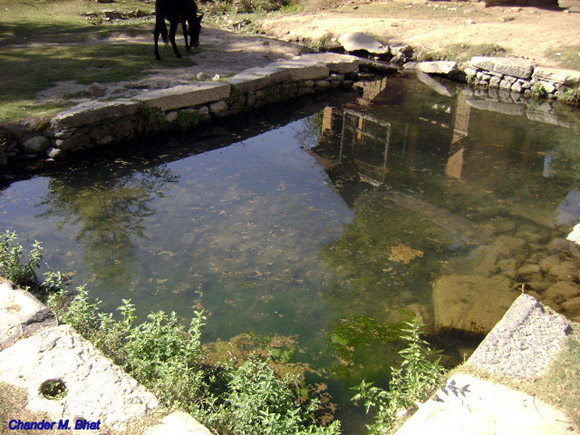
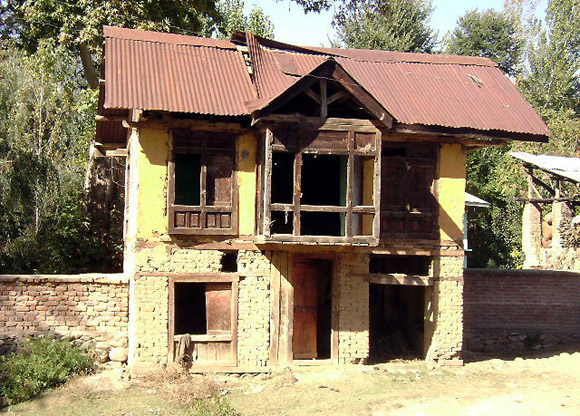
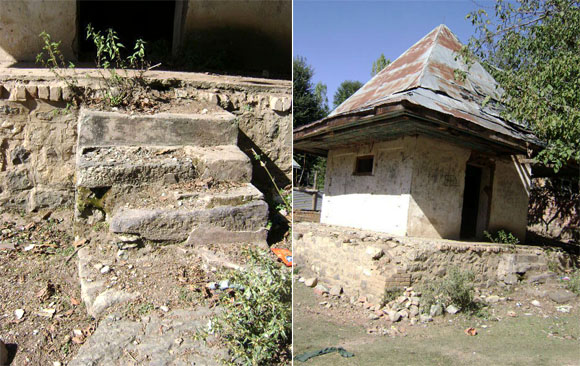

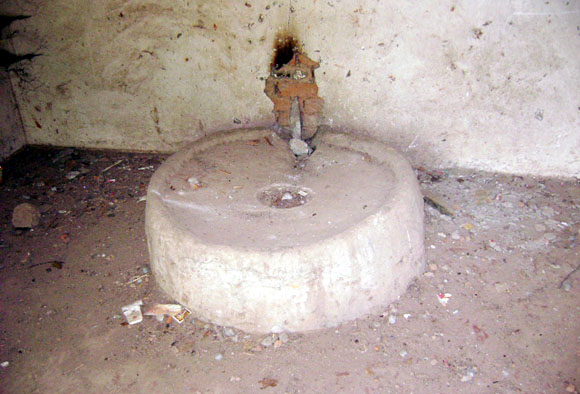
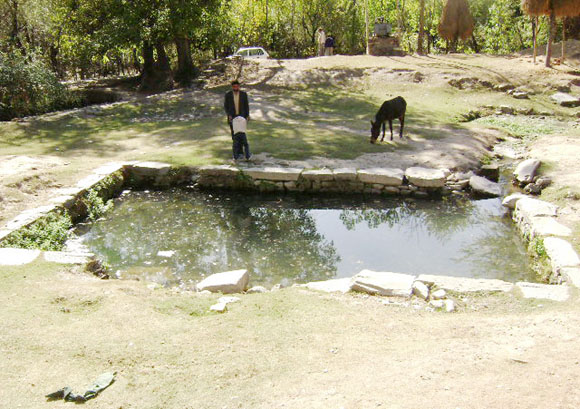
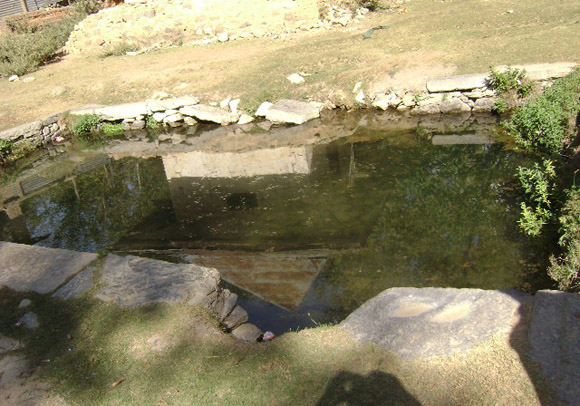
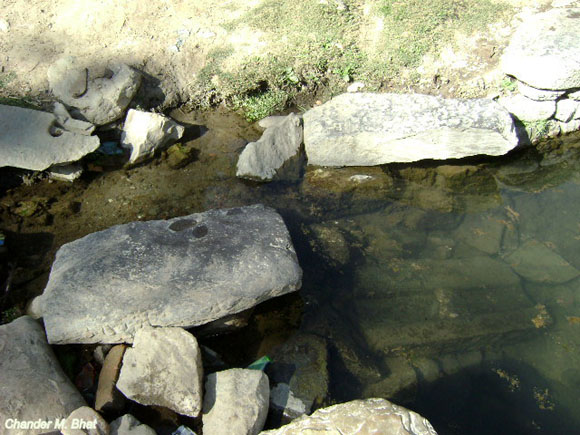
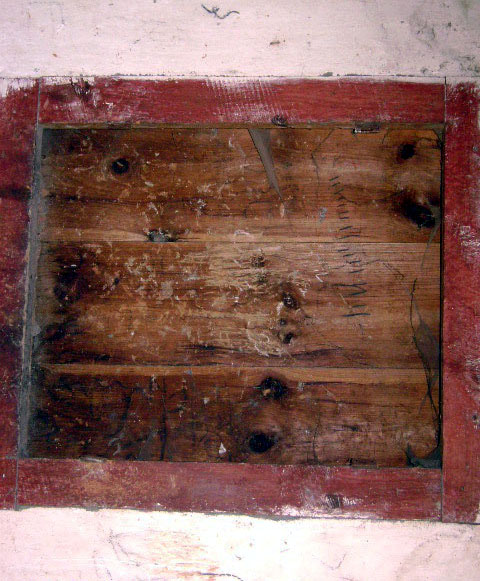

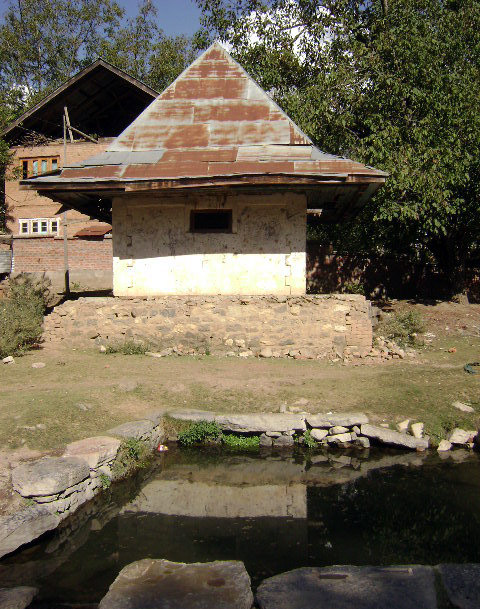

 *Born on 20th March, 1960 in Murran a village in North Kashmir,
Chander M. Bhat is presently working as an Assistant Supdt. Posts, in
Department of Posts, Govt. of India. His articles regarding Posts and of
non-political nature stand widely published in various papers and
magazines of the country. A booklet 'How to Collect Stamps" published by
the Department of Posts, has earned him genuine accolades. He worked on
the project of tracing the roots of his co-villagers and of the village
Murran, resulting into the culmination of a widely acclaimed book
"Murran -My Village". Man with depth, Chander M. Bhat has also another
book, "Ocean by Drops" (collection of poems) in his vase having colorful
poems. His book "Ancient History of Jammu and Kashmir", confirms his
researching capability. Various research papers like "The Splendor that
is Amarnath" and "Vitasta" The Sacred River of Kashmir" are valuable
additions to his works that has proved very fruitful and guiding force
in the exile period of Kashmiri Pandits community of which the author is
also a member.
*Born on 20th March, 1960 in Murran a village in North Kashmir,
Chander M. Bhat is presently working as an Assistant Supdt. Posts, in
Department of Posts, Govt. of India. His articles regarding Posts and of
non-political nature stand widely published in various papers and
magazines of the country. A booklet 'How to Collect Stamps" published by
the Department of Posts, has earned him genuine accolades. He worked on
the project of tracing the roots of his co-villagers and of the village
Murran, resulting into the culmination of a widely acclaimed book
"Murran -My Village". Man with depth, Chander M. Bhat has also another
book, "Ocean by Drops" (collection of poems) in his vase having colorful
poems. His book "Ancient History of Jammu and Kashmir", confirms his
researching capability. Various research papers like "The Splendor that
is Amarnath" and "Vitasta" The Sacred River of Kashmir" are valuable
additions to his works that has proved very fruitful and guiding force
in the exile period of Kashmiri Pandits community of which the author is
also a member.